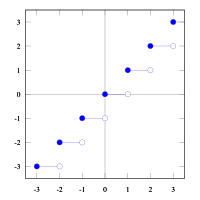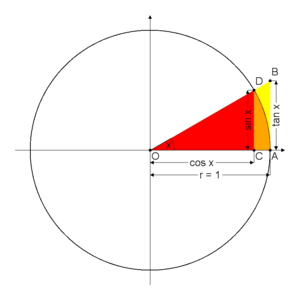Introduction to Calculus/Limits
| This lesson assumes you have a working knowledge of the topics presented in the following lessons: |
Introduction to Limit andLimit processes are the basis of calculus. As opposed to algebra, where a variable is considered to have a fixed value (think of the solution of word problems, where there are one or more discrete answers), we allow a variable to change continuously and study how a function's value changes.
[edit | edit source]Outline
[edit | edit source]This article addresses limits of functions of a single variable. It starts with an informal definition, discusses the basic properties of the limit operation, and progresses to the precise definition of limit. This rigorous definition is used to prove the earlier results, which were stated without proof. A number of examples of applying the definition are given, which helps develop facility with inequalities.
An Informal Definition
[edit | edit source]Consider the function . As x increases, y increases. As we crank x up towards a number, say 100, y gets closer to the number 200.
Limits are concerned with what the value of a function (in this case, y) approaches as a variable it is based on (in this case, x) approaches a number (in this case, 100), not the actual value of the function when the variable equals the number. This is useful because not all functions are continuous and you may get a different result in the limit of y as you crank x down instead of up to that number.
Continuous Functions
[edit | edit source]

- Look at these two graphs. Notice that the top one is a single, unbroken curve, whereas the bottom one has many "jumps." Now the top graph is continuous and the bottom one is not. This is the basic idea of continuity for a function; a function that is not continuous will have jumps. Points themselves can also be continuous and not continuous. For example, the point where x equals -1/2 in the second graph is continuous because there are no jumps in that specific section. On the other hand, where x equals two, there is a jump, so the point is not continuous. Not a very formal definition, this jump thing! Because the jump thing is so informal, they invented a new way to phrase it using limits
Definition of a Continuous Function
[edit | edit source]Say we want to prove that the top function is continuous for all values between -3 and 3. (This is a closed interval, or a section of a function that includes the two endpoints. Likewise, an open interval is a section of a function that does not include the two endpoints. The closed interval between -3 and 3 includes -3 and 3; the open interval does not.) The first definition is that of continuity in an interval
we want to prove that the top function is continuous for all values between -3 and 3. (This is a closed interval, or a section of a function that includes the two endpoints. Likewise, an open interval is a section of a function that does not include the two endpoints. The closed interval between -3 and 3 includes -3 and 3; the open interval does not.) The first definition is that of continuity in an interval
- Definition of continuity in a closed interval
- A continuous closed interval is continuous at every point, including the left and right endpoints.
Not too complicated, eh? Now on to the definition of continuity at a point that is in a open interval; that is, not including the endpoints
- Definition of continuity at a point in an open interval in a function
- Let c be the x-value of the coordinate where we want to prove that the function is continuous. The function f is said to be continuous at the point c if the three following conditions hold:
- exists,
- exists, and
Now, when can the limit as x approaches c not exist? Just look at the second graph! If you try to find the limit at two from numbers larger than two, you get a result that does not equal the results from using numbers smaller than two! There is a way to write this mathematically, so we define new types of limits.
- The mathematical way to write "The limit of f(x) as x approaches c created by using numbers larger than c" is
- The mathematical way to write "The limit of f(x) as x approaches c created by using numbers smaller than c" is
Basic Theorems for Limit Operations
[edit | edit source]The limit operator satisfies linearity. That is, "the limit of sum, is the sum of the limits".
There are also basic rules for doing arithmetic with limits. They can be found in the calculus textbook for reference. Follow this link and study the limits. Convince yourself that these rules are intuitive. Also note that if f(a) is defined, and if f is a continuous function, then .
Proofs
[edit | edit source]What does equal?
Find the value of this expression for values close to 5:
| 4 | 4.9 | 4.99 | 4.999 | 4.9999 | 5.0001 | 5.001 | 5.01 | 5.1 | 6 | |
| 16 | 24.01 | 24.9001 | 24.990001 | 24.99900001 | 25.00100001 | 25.010001 | 25.1001 | 26.01 | 36 |
Notice how, as we get closer to 5 from both sides, the value of the function, x2 approaches 25. This may seem obvious, since 5 squared actually equals 25. In fact, the limit of f(x) as x approaches c in a continuous open interval is equal to f(c) if it is defined. However, this problem is merely to help you get acquainted to limits, before we go into limits about a very special quotient, 0/0 and other indeterminate forms, or expressions that cannot be determined by substituting c for x in a limit where x goes to c.
NOTE: Wikipedia is a very good reference on these limits; however, avoid going into the section on evaluating indeterminate limits, for this uses a statement called l'Hôpital's rule. This is a useful rule but is confusingly unnecessary until you know what a derivative is.
Notice that 0/0 by itself is meaningless; also notice that equals one, since for all values near 0, x/x=1.
The main purpose of limits
[edit | edit source]You can find otherwise undefined expressions with limits. They allow you to use algebraic rules, even at values when the rules are false! For example, look at . What does this equal?
Let's use an algebraic rule that is true at all values of x besides zero. The rule states that equals x for all numbers beside 0. When we apply this rule to our old limit, we see that the limit is equivalent to , which is easily seen to be equal to 0.
For more on finding limits, see the calculus wikibook.
A More Precise Definition of Limit
[edit | edit source]- For almost all purposes, the informal definition of a limit works very well; however, because of its vague wording, it is very dificult to use it in any sort of proof about limits. For proofs, the formal definition of a limit, from Wikibooks, is used instead.
Applying the Definition
[edit | edit source]Limits involving Polynomials
[edit | edit source]Finding the limit of a polynomial is a simple process. The easiest method of taking the limit of a polynomial is substitution. The value of a polynomial as x approaches a is equal to f(a). Consider the following example:
Limits involving Rational Functions
[edit | edit source]Limits involving Trigonometric Functions
[edit | edit source]
This is a unit circle. It has a radius of one unit, and its angles are measured in radians. Using this circle, we can prove that
- Notice that this makes sense, since as theta approaches 0, arc DA becomes very close to being congruent to arc DC. This doesn't prove anything, though! To prove this, we need to look at areas. First notice that , since each area contains the last are, plus another layer. Now, we can find the area of these three areas. The first area, ODC, is a triangle. This triangle has a base of , and it has a height of . Using the area formula for a triangle, we find
- Now, we go on to the next area, ODA. It is a sector of a circle. The formula to find the area of the sector of a circle is
- This makes sense, since when you think that a complete circle would have two pi radians, the formula turns into the formula for a circle. In our unit circle, the area is simply , since the radius is one.
- The third area is also a triangle, with height of , or . With a base of one, its area turns into
- Now from the original expression of , we have
- Multiply this whole inequality by two
- Now divide the whole thing by
- Now we apply the limit!





























